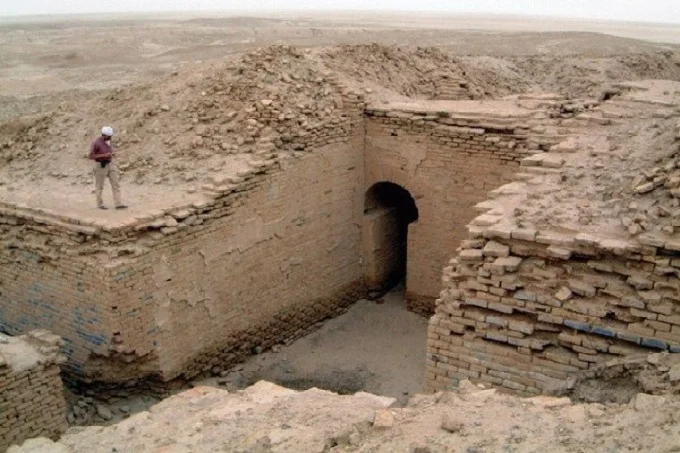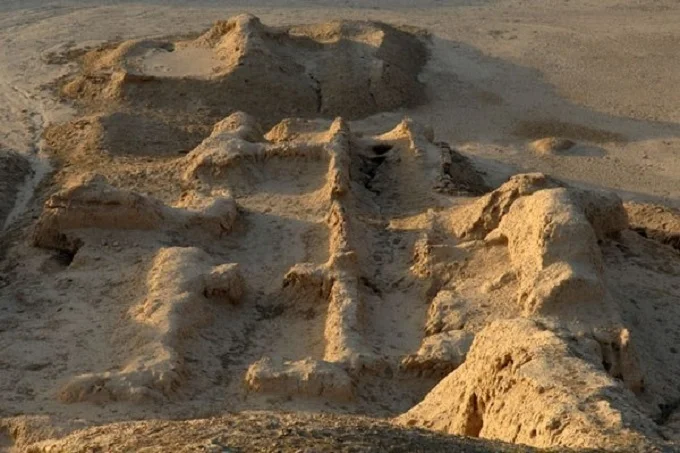The shadows of ancient Uruk

This city was located in Mesopotamia, in the lower reaches of the Euphrates. It is located on the border between the steppe and the desert. Now it is the territory of Iraq.
Life was seething here long before Rome and Athens, even long before Babylon. When the Sumerians came here, Uruk was already an ancient city. Five dynasties of Sumerian kings ruled it, then they were replaced by the Akkadians. It was conquered by the Babylonians and Assyrians, Persians, later Greeks and Romans, Parthians, and, finally, Arabs. However, Uruk died, covered by the sands of the desert. Today, the years of his birth and decline date back to the XXX – XXVIII centuries BC!
Centennial excavations
In 1902, the German archaeologist Walter André discovered Uruk under a 15-meter layer of sand. At that time, a new stage in the study of ancient Mesopotamia began, which had been excavated for a hundred years now. Over the years, the ruins of such cities as Babylon, Kalhu, Nivea, Lagash, and Nippur have appeared from under the sand.
In 1922, the city of Ur appeared before the eyes of the people, and ten years later, in the upper reaches of the Euphrates, Mari. During the excavations of Mari, an amazing treasure was found – a golden eagle with a lion’s head.
The greatness of Uruk shocked the imagination of even worldly-wise archaeologists. They admired two huge temple towers dedicated to the goddess of love Ishtar and the heavenly patron of the city – Anu. Four more temples and a magnificent royal palace were excavated. But even this did not impress the researchers. It seemed that the city was built not by ancient people with antediluvian construction equipment, but by representatives of a highly developed civilization.
The paved streets were so wide that three chariots drawn by four horses each could rush through them at the same time. The townspeople, apparently, got used to comfort – heating, sewerage were carried out in their houses, each had a bathroom, the floor, and walls of which were covered with mosaic paintings. To get the latest stories, install our app here.

Incredible find
But the most incredible find was twelve clay tablets with Sumerian cuneiform writing, which were in the palace library of the Assyrian king Ashurbanipal. As is known, Sumerian cuneiform arose in the 4th and 3rd millennium BC. Written signs were applied with a pointed stick on wet clay tiles, or tablets. The scribes pressed the clay with the corner of a rectangular stick, and the inscription took the form of wedge-shaped depressions.
The first cuneiform tablets appeared in Europe in 1626. They were brought from Persepolis by the Italian traveler Pietro Della Balle. For more than a hundred years, no one could decipher them, until in 1802 the German teacher Georg Grotefeld suggested that the tablets were in Persian text, and in this case, they should have the names of Persian kings. He managed to decipher the names of Xerxes and Darius and, in the end, guess the meaning of ten cuneiform characters. Following Grotefeld, other researchers took up deciphering.
By that time, archaeologists had tens of thousands of tablets. And when the library of King Ashurbanipal was discovered, experts were already able to read the fragments of texts written on them, from which they learned about kings and wars, life, religion, trade, crafts and just the everyday life of people who built beautiful cities five thousand years ago. It turned out that these tablets also contain fragments of an ancient epic about the great king Gilgamesh, who until then was considered a fictional figure.
By the way, thanks to the deciphered text, it became clear that the city that Walter Andre discovered is Uruk, built on the orders of Gilgamesh.
Gilgamesh – son of god
“No one on the whole vast ball that floats in the ocean of the Universe and is called the Earth was equal to Gilgamesh. The gods themselves fell in love with him when the divine mother Ninsun gave birth to him from the mortal Lugalbanda,” one of the oldest texts of mankind begins with these words about Gilgamesh and Uruk, erected by his order. To get the latest stories, install our app here.
This king was handsome, smart, brave, and strong. He was called a cruel ruler, but they obeyed unquestioningly, because they saw that all his orders were aimed at the benefit of the people, and because, of course, Gilgamesh was half a god. Ancient chroniclers reported on the exhausting work of all male subjects in the construction of powerful walls around the city. They made bricks day and night, fired them, and piled them up. Those who did not want to obey were immediately subjected to a cruel execution.

But one day, the subjects of the cruel king decided to complain to the god Anu, the heavenly patron of the city. “Gilgamesh is our lord,” they said, “He is wise and powerful, but because of him, we do not see the white light, spending our whole lives on construction.”
So instead of simply punishing Gilgamesh or forcing him to relent, the goddess of creation Aruru molded, at the request of Anu, a wild man Enkidu from a clay shoe, who was supposed to defeat the king in order to prove that he was not omnipotent, and then show him his place.
Death of the Innocent Enkidu
And then, one day in the desert where Enkidu lived, the priestess of her temple sent by the goddess Ishtar came. “Why do you live here alone?” – asked the messenger of the goddess. “Come with me to the city, where you can see me every day.” Struck by the beauty of the girl, Enkidu went along with the priestess. In the city, he met with Gilgamesh, quarreled with him, and offered to fight. But it turned out that the forces of the rivals were equal – none of them could prevail, and then, to the surprise of the gods, Gilgamesh and Enkidu fraternized.
Together, these two heroes accomplished many feats. But one day it happened that Ishtar offered her love to the king, and he, having heard about her lustfulness and bad temper, did not want to deal with the goddess. Then, in a rage, Ishtar sent a disease to the named brother of Gilgamesh, who rejected her, and after 12 days, the innocent Enkidu died in terrible agony.
The king who became immortal
Saddened, Gilgamesh tried to save Enkidu from the realm of death, but to no avail. And then it occurred to him to try to find a way to live forever. In search of eternal life, the king wandered the Earth, performing amazing feats along the way, but never reached his goal. And only once, crossing the river, he seems to have gained the highest wisdom thanks to the ferryman, who said: “Man is mortal. Eternal life is the fate of the gods. You can immortalize your name with great deeds.”
On one of the tablets found by archaeologists, it is written that Gilgamesh really immortalized his name, the personification of which was the glorious city of Uruk he built. For many years, Uruk was hidden from human eyes under the sands, but now it shone again in its glory, and with it appeared to the world of people and Gilgamesh, who gained a new life. To get the latest stories, install our app here.




